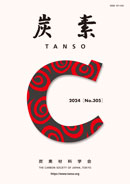Volume 2024, Issue 305
Displaying 1-21 of 21 articles from this issue
- |<
- <
- 1
- >
- >|
Contents
-
2024 Volume 2024 Issue 305 Pages 305_toc1-305_toc2
Published: January 31, 2024
Released on J-STAGE: January 31, 2024
Download PDF (279K)
-
2024 Volume 2024 Issue 305 Pages 1-22
Published: January 31, 2024
Released on J-STAGE: January 31, 2024
Download PDF (15378K)
Preface
-
2024 Volume 2024 Issue 305 Pages 23
Published: January 31, 2024
Released on J-STAGE: January 31, 2024
Download PDF (316K)
Accounts
-
2024 Volume 2024 Issue 305 Pages 24-29
Published: January 31, 2024
Released on J-STAGE: January 31, 2024
Download PDF (814K) -
2024 Volume 2024 Issue 305 Pages 30-41
Published: January 31, 2024
Released on J-STAGE: January 31, 2024
Download PDF (6120K)
Welcome to Our Laboratory
-
2024 Volume 2024 Issue 305 Pages 42-43
Published: January 31, 2024
Released on J-STAGE: January 31, 2024
Download PDF (2187K)
Recent Doctoral Thesis
-
2024 Volume 2024 Issue 305 Pages 44-45
Published: January 31, 2024
Released on J-STAGE: January 31, 2024
Download PDF (378K)
From Newcomer
-
2024 Volume 2024 Issue 305 Pages 46
Published: January 31, 2024
Released on J-STAGE: January 31, 2024
Download PDF (590K)
Reports
-
2024 Volume 2024 Issue 305 Pages 47-57
Published: January 31, 2024
Released on J-STAGE: January 31, 2024
Download PDF (6748K) -
2024 Volume 2024 Issue 305 Pages 58-59
Published: January 31, 2024
Released on J-STAGE: January 31, 2024
Download PDF (3831K) -
2024 Volume 2024 Issue 305 Pages 60
Published: January 31, 2024
Released on J-STAGE: January 31, 2024
Download PDF (163K) -
2024 Volume 2024 Issue 305 Pages 61
Published: January 31, 2024
Released on J-STAGE: January 31, 2024
Download PDF (814K) -
2024 Volume 2024 Issue 305 Pages 62-65
Published: January 31, 2024
Released on J-STAGE: January 31, 2024
Download PDF (5905K) -
2024 Volume 2024 Issue 305 Pages 66-72
Published: January 31, 2024
Released on J-STAGE: January 31, 2024
Download PDF (4352K) -
2024 Volume 2024 Issue 305 Pages 73
Published: January 31, 2024
Released on J-STAGE: January 31, 2024
Download PDF (180K)
TANSO Salon
-
2024 Volume 2024 Issue 305 Pages 74-75
Published: January 31, 2024
Released on J-STAGE: January 31, 2024
Download PDF (2446K)
-
2024 Volume 2024 Issue 305 Pages 76-78
Published: January 31, 2024
Released on J-STAGE: January 31, 2024
Download PDF (290K)
-
2024 Volume 2024 Issue 305 Pages 79-80
Published: January 31, 2024
Released on J-STAGE: January 31, 2024
Download PDF (329K) -
2024 Volume 2024 Issue 305 Pages 81-82
Published: January 31, 2024
Released on J-STAGE: January 31, 2024
Download PDF (193K)
-
2024 Volume 2024 Issue 305 Pages 83-87
Published: January 31, 2024
Released on J-STAGE: January 31, 2024
Download PDF (126K)
-
2024 Volume 2024 Issue 305 Pages 88
Published: January 31, 2024
Released on J-STAGE: January 31, 2024
Download PDF (193K)
- |<
- <
- 1
- >
- >|
